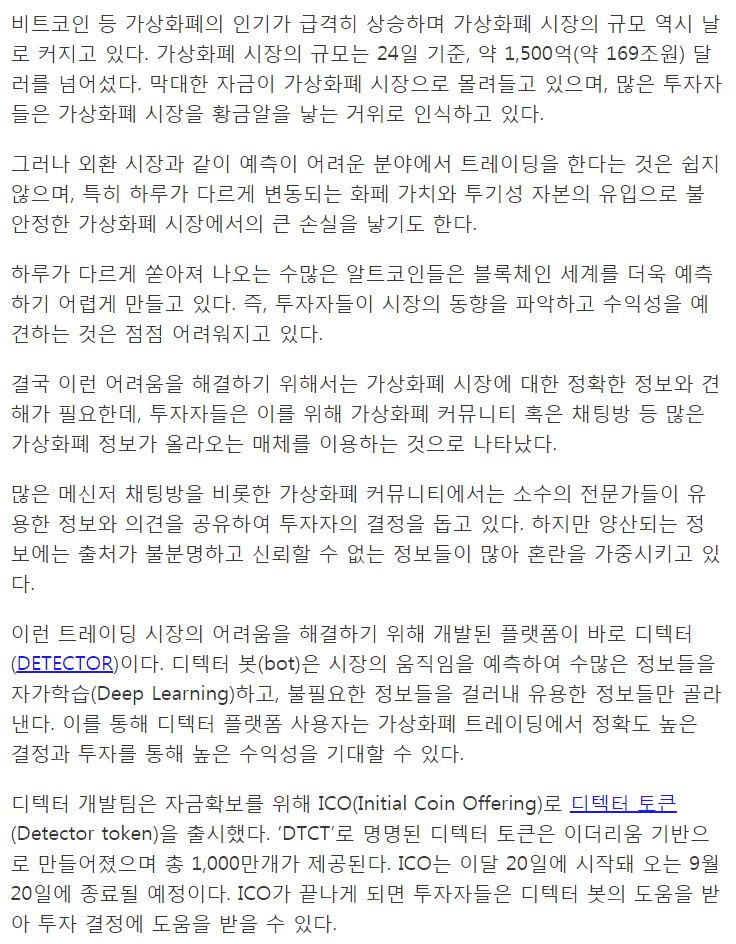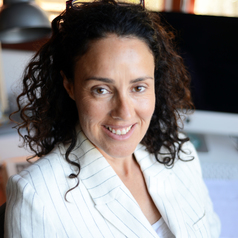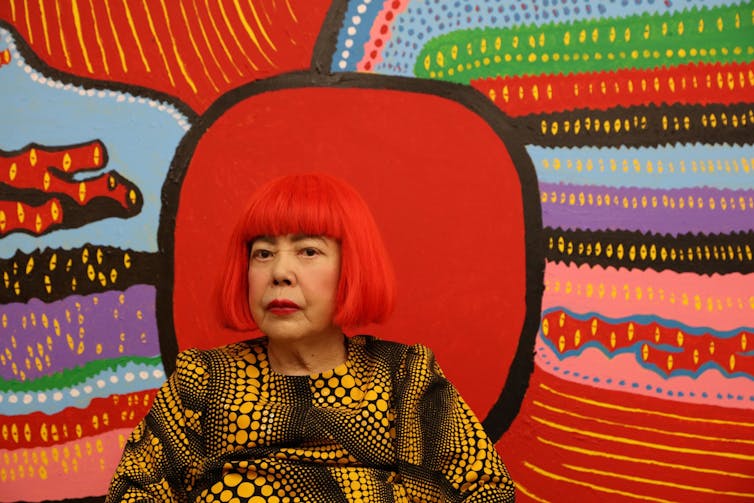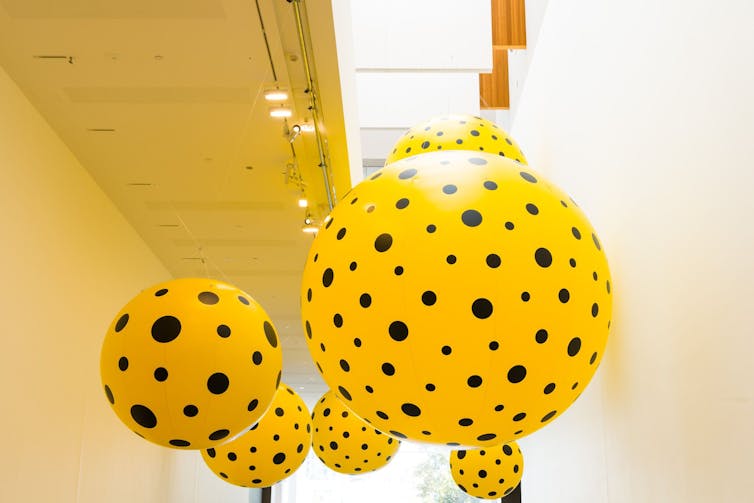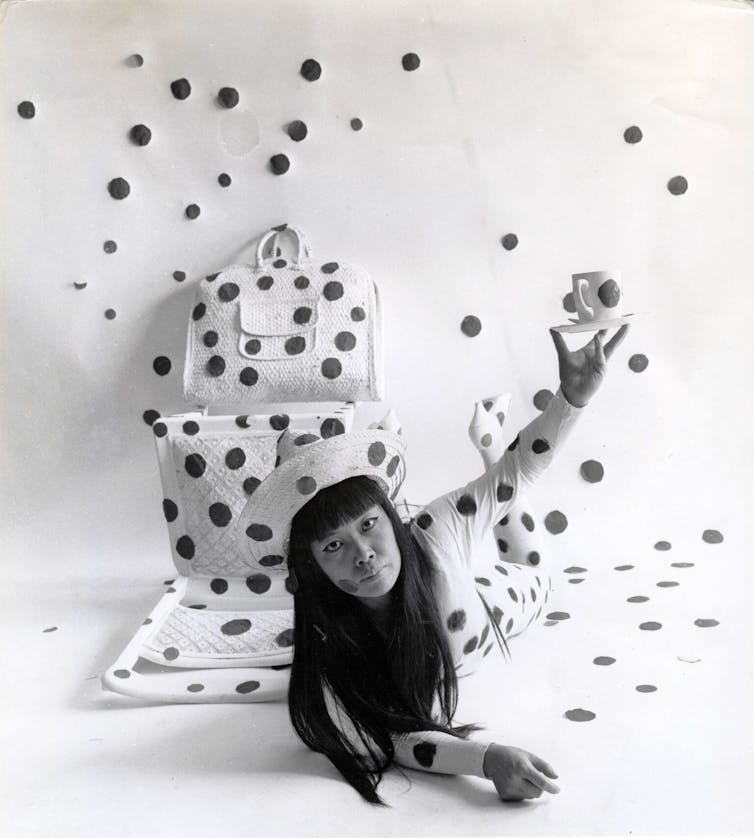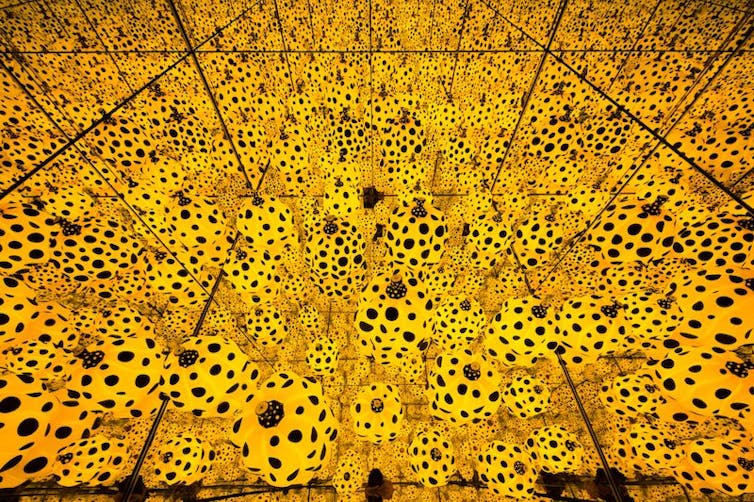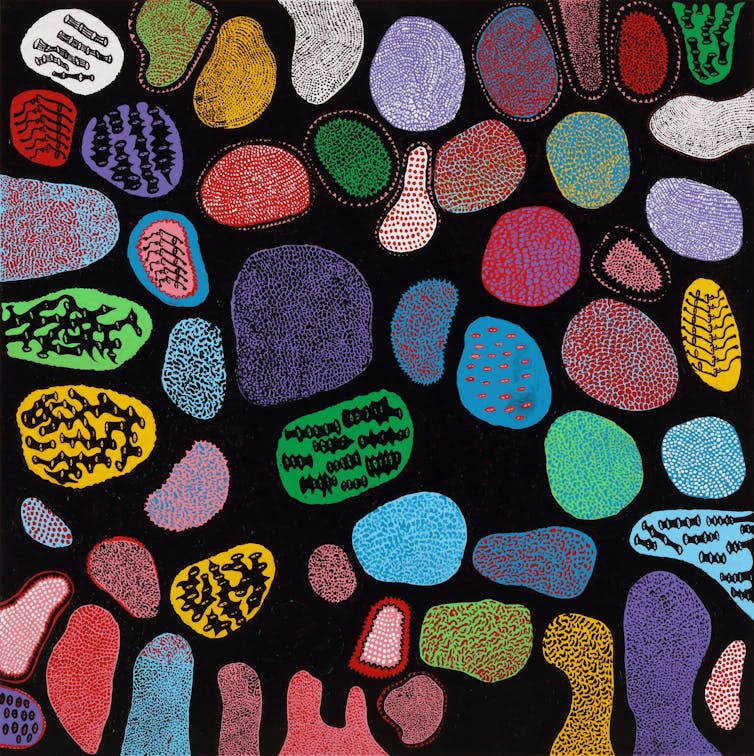Yayoi Kusama is arguably Japan’s most famous living artist. Born in 1929, she is one of the few practising artists whose work spans the most important “isms” of the 20th century. At the same time, her work is undeniably contemporary. For decades, her dazzling mirror and polka-dot infused installations, or “Infinity” rooms have enthralled audiences.
First developed in 1965, the mirrored interiors multiply and reflect, expanding outwards ad infinitum. This vertiginous, almost hallucinatory experience has evolved to become trademark Kusama and feels incomplete without the now mandatory selfie in this ever expanding universe of dots, lights and mirrors.
Yayoi Kusama in front of Life is the Heart of a Rainbow (2017) ©YAYOI KUSAMA, Courtesy of Ota Fine Arts, Tokyo/Singapore, Victoria Miro, London, David Zwirner, New York
After an astonishing 65 years of artistic output, a new survey exhibition of her work has just opened at Brisbane’s Gallery of Modern Art (GOMA). Importantly, it provides a historical context to these rooms, tracing key strains in Kusama’s artistic development. Co-curated with the Singapore National Art Gallery, the exhibition cements GOMA’s long association with the artist. Kusama’s Narcissus garden (1966/2002) is a much-loved icon in the permanent collection. The scores of silver mirrored balls provide endlessly reflective surfaces as they float serenely in GOMA’s Watermall.
Kusama enthusiasts will be delighted with new works created this year such as the enormous balloons floating mid-air in GOMA’s long gallery. The balloons are coloured in Kusama’s distinctive yellow and black polka dots, welcoming the visitor to the exhibition with a weightless, ethereal presence.
Installation view: Yayoi Kusama: Life is the Heart of the Rainbow at the Gallery of Modern Art, Brisbane, 2017. Natasha Harth, QAGOMA
It is virtually impossible to separate Kusama’s life from her practice. As a small child growing up in Japan, she suffered hallucinations in the form of fields of dots. These hallucinations have continued throughout her life and the dots became a crucial recurring motif.
In 1958 Kusama arrived in New York via a short stay in Seattle and immediately immersed herself in the vibrant avant-garde artistic community, associating with Joseph Cornell, Donald Judd, Claes Oldenberg and Andy Warhol. It was a notoriously heady and experimental decade, and Kusama’s work quickly expanded beyond the canvas encompassing performance and fashion design.
The exhibition is organised chronologically, making it possible to chart Kusama’s artistic development through the decades. Kusama was trained in Nihonga painting, a hybrid style combining traditional Japanese techniques and materials with 19th-century European landscapes. From 1951 until she left for the US in 1957, Kusama worked almost exclusively on these small works on paper, experimenting with watercolour, gouache and oil paint. In these strange and murky almost-landscapes, it is possible to detect the embryonic formation of the dots and nets that were to come later.
Kusama’s preoccupation with repetition and infinity comes to the fore with the “Infinity nets” series. Originally small paintings on paper, the nets grew, responding to the influence of Jackson Pollock and the abstract expressionists’ exploitation of scale. The paintings are an optical sensation, expanding and contracting as if they are breathing. With no clear beginning or end, they throb and pulse, giving the impression they could extend forever, beyond the confines of the canvas.
Yayoi Kusama. Self-Obliteration by Dots (1968) Collection of the Artist © YAYOI KUSAMA. Photo by Hal Reiff.
One of the most fascinating aspects to the exhibition are the photographs documenting her performances, or “Happenings” during the 1960s and early 1970s. If Kusama’s “Infinity” rooms anticipated today’s selfie culture, there is something wonderfully nostalgic and utopian about these images.
Kusama was engaged in the social and political upheaval of the time, including anti-Vietnam war protests. In one photograph, a group of participants are shown nude protesting on Brooklyn Bridge, covered in her signature polka dots. In her autobiography, Infinity Net, Kusama recalls writing an open letter to President Richard Nixon, promising to “paint each other with polka dots” if he withdrew from Vietnam.
Kusama returned to Japan in 1973, and has lived voluntarily in a psychiatric facility since 1975. Virtually forgotten by the New York art community, her career was resurrected when she represented Japan at the 1993 Venice Biennale. It was during this period that yellow and black pumpkins emerged as an important new motif in her work.
As a child, her family had owned a nursery. Pumpkins were familiar and comforting, and a major part of her diet. The 1993 Venice installation is recreated in one of the centrepieces of the exhibition, The Spirits of the Pumpkins Descended into the Heavens (2015). The visitor enters a room that has been painted with her trademark pumpkin-inspired yellow and black polka dots.
Yayoi Kusama The Spirits of the Pumpkins Descended into the Heavens 2015. Collection of the Artist, ©YAYOI KUSAMA. Installation view at National Gallery Singapore, 2017.
In the middle of a room sits a mirrored cube. A series of small peep-hole windows allows the visitor to gaze at the interior containing an array of pumpkin sculptures. The effect is startling. The mirrors reflect the pumpkins infinitely onward and outward, collapsing the boundary between interior and exterior space.
Serial repetition returns in a recent series “My Eternal Soul”. Arranged in a grid-like formation around the gallery walls, Kusama’s emphasis on repetition explodes with vibrant colour.
Yayoi Kusama. Everlasting Beauty for the Never Ending Universe (2016). Collection of the Artist ©YAYOI KUSAMA, Courtesy of Ota Fine Arts, Tokyo/Singapore, Victoria Miro, London, David Zwirner, New York
The sculptures placed in the middle of the room repeat the organic shapes and forms on the canvases. The series serves a potent reminder: even at 88, Kusama is still introducing new diverse visual forms in her practice. The optical illusions are still there, emboldened through dynamic juxtapositions of colour.
Yayoi Kusama: Life is the Heart of a Rainbow is at Brisbane’s Gallery of Modern Art until 11 February 2018. The exhibition is free.
 Chari Larsson does not work for, consult, own shares in or receive funding from any company or organisation that would benefit from this article, and has disclosed no relevant affiliations beyond their academic appointment.
Chari Larsson does not work for, consult, own shares in or receive funding from any company or organisation that would benefit from this article, and has disclosed no relevant affiliations beyond their academic appointment.



 Asian Fund Managers Turn More Optimistic on Growth but Curb Equity Return Expectations: BofA Survey
Asian Fund Managers Turn More Optimistic on Growth but Curb Equity Return Expectations: BofA Survey  How to support someone who is grieving: five research-backed strategies
How to support someone who is grieving: five research-backed strategies  6 simple questions to tell if a ‘finfluencer’ is more flash than cash
6 simple questions to tell if a ‘finfluencer’ is more flash than cash  The American mass exodus to Canada amid Trump 2.0 has yet to materialize
The American mass exodus to Canada amid Trump 2.0 has yet to materialize  Why financial hardship is more likely if you’re disabled or sick
Why financial hardship is more likely if you’re disabled or sick  Glastonbury is as popular than ever, but complaints about the lineup reveal its generational challenge
Glastonbury is as popular than ever, but complaints about the lineup reveal its generational challenge  Parents abused by their children often suffer in silence – specialist therapy is helping them find a voice
Parents abused by their children often suffer in silence – specialist therapy is helping them find a voice  Every generation thinks they had it the toughest, but for Gen Z, they’re probably right
Every generation thinks they had it the toughest, but for Gen Z, they’re probably right  Columbia Student Mahmoud Khalil Fights Arrest as Deportation Case Moves to New Jersey
Columbia Student Mahmoud Khalil Fights Arrest as Deportation Case Moves to New Jersey  Yes, government influences wages – but not just in the way you might think
Yes, government influences wages – but not just in the way you might think  Debate over H-1B visas shines spotlight on US tech worker shortages
Debate over H-1B visas shines spotlight on US tech worker shortages  Office design isn’t keeping up with post-COVID work styles - here’s what workers really want
Office design isn’t keeping up with post-COVID work styles - here’s what workers really want 










